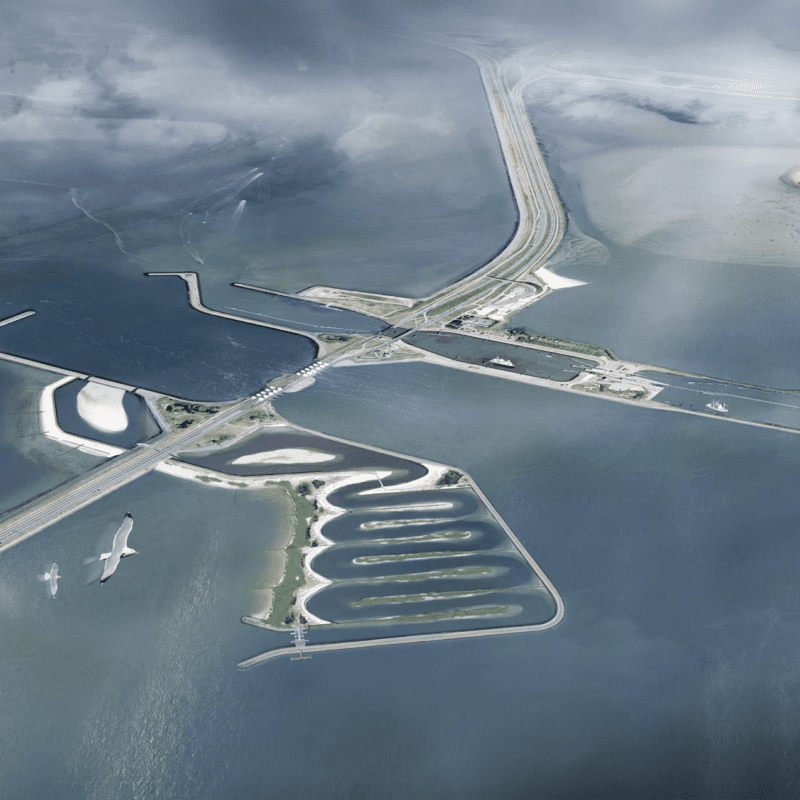Why
In order to grow and reproduce, migratory fish need both salt and fresh water. The Afsluitdijk makes it almost impossible for these animals to migrate back and forth between the Wadden Sea and the IJsselmeer. Numerous fish wait in the Wadden Sea before the drainage locks. They smell the fresh water and desperately want to reach it, but the flow rate is too high for most fish species. This is one of the main reasons why the migratory fish population is alarmingly low.
Restoring nature
The Fish Migration River restores a crucial link in the swimming routes of migratory fish. As a result, the water quality of the IJsselmeer improves, and the number of plants and animals in the area will increase. The recovery of fish populations is also important for the many birds that mainly eat fish. Moreover, it eventually provides more room for professional and recreational fishing.
World's first
The Fish Migration River near Kornwerderzand is the first in the world in terms of scale and complexity. Years of preparation preceded the determination of the best design for all types of migratory fish. It is the first time that an artificial tidal river is constructed where fresh and saltwater meet. An estimated 200 locations worldwide could benefit from this innovative approach.
Monitoring and Scientific Research
To understand the influence of the environment on the behavior of migratory fish in the Wadden Sea area, the Fish Migration River is used as a test facility. In collaboration with the Waddenacademie (Wadden Academy), knowledge is acquired that provides answers to the research and management questions in the Wadden Sea area and possibly beyond. This scientific research is financially supported by the Waddenfonds (Wadden Fund).
How
The Fish Migration River is a few kilometers long winding river, through the Afsluitdijk. This allows migratory fish to swim between the salty Wadden Sea and the fresh IJsselmeer whenever they want. The Fish Migration River follows the tides of the Wadden Sea and has varying flow rates. Sweet and salty water gradually converge, allowing the fish to slowly acclimate during their journey. To enable fish to pass through the Afsluitdijk, we create an opening in the dike. Innovative gates ensure that the hinterland remains protected during extreme high tides.
We are constructing the Fish Migration River to the west of the drainage locks at Kornwerderzand. This is the most ideal location because large amounts of fresh water from the IJsselmeer are discharged into the Wadden Sea through the Lorentz locks here. The fresh water attracts the fish to this location. The Fish Migration River connects to the deep channels in the bottom of the Wadden Sea and the IJsselmeer, forming a ‘highway’ for the fish.
Sustainability and circularity
We aim to build the Fish Migration River as sustainably as possible. Therefore, we explore opportunities for reusing material. Until now, the realisation of several projects has been almost entirely done with materials from the area. We utilise:
- Rubble from reinforcing the Afsluitdijk
- Sand from the navigation channel at Kornwerderzand
- Soil from transforming the N31 near Harlingen and from the reinforcement of the Afsluitdijk
- Reed transplanted from the Makkumer Noordwaard.
The Power of Collaboration
The initiators of the Fish Migration River are the Waddenvereniging, It Fryske Gea, Sportvisserij Nederland, NetVISwerk, and the coalition Het Blauwe Hart Natuurlijk. The project is carried out on behalf of the Province of Fryslân.
Construction consortium Levvel (BAM, Van Oord, and Rebel) has created the passage in the Afsluitdijk. The contractors IJsselmeerwerken VOF (Bam, Van Oord) shapes the contours on both sides of the Afsluitdijk. Contractor Boskalis creates the unique river.
The project is financially supported by the Province of Noord-Holland, the Province of Fryslân, the Dutch government, Waddenfonds, LIFE, Natura2000, the Nationale Postcode Loterij and CEF. The total costs amount to approximately 60 million euros.
Experience the Fish Migration River
The Waddenvereniging and It Fryske Gea organise excursions at the location where the Fish Migration River is being built. You will learn about fish, their behavior, and the Fish Migration River. Highly recommended for both young and old!
You can learn more about the project at the Afsluitdijk Wadden Center. There, you will find, among other things, a VR experience that allows you to swim through the Fish Migration River as fish would.
In the future, you will be able to visit the Fish Migration River and experience the unique process of fish migration on the spot.
When
We are constructing the Fish Migration River in various phases. After years of preparation, the construction started in 2019. Rijkswaterstaat completed the work on the passage through the dike in 2023. It is anticipated that the first fish will swim through the Fish Migration River by the end of 2025. In the subsequent years, we will monitor the functioning of the Fish Migration River and make adjustments when necessary. We will also observe the behavior of the migratory fish swimming through the Fish Migration River.






